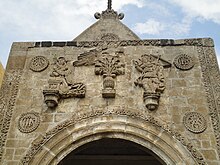Tequitqui or tequitqui art is a term that refers to the artistic manifestations carried out by indigenous people of Mesoamerican area after the Conquest of Mexico. It was proposed by José Moreno Villa in his text The Mexican in the Arts (1949).[1]


"It is the mestizo product that appears in America when indigenous people interpret the images of an imported religion (...) it is subject to indigenous superstition. It is a strange mixture of styles belonging to three eras: Romanesque, Gothic and Renaissance.It is anachronistic, it seems to have been born out of time, because the Indian indoctrinated by the friars or the teachers coming from Europe, received as models prints, drawings, ivories, rich embroidered fabrics, breviaries, crosses, and a thousand minor objects. Not all of them obeyed the same style and the same era"
— José Moreno Villa. The Mexican in the plastic arts.[2]
The term tequitqui means "tributary." The European iconographic and technical influence fused with indigenous technique and iconography gave rise to a set of unique pictorial and sculptural manifestations. This was manifested mainly in the portals of the Christian temples, atrial crosses and murales in the cloisters and open chapels of the convents. The term Indo-Christian art is also used as a synonym, proposed by Constantino Reyes-Valerio in the work of the same name.[citation needed]
Bibliography
- "Considerations around the so-called Tequitqui Style"", Dichotomy between cult art and folk art, Mexico: Universidad Nacional Autónoma de México, Institute of Aesthetic Research, 1975, pp. 135–1 161, OCLC 58425586, retrieved Jan 26, 2020